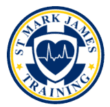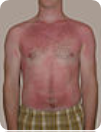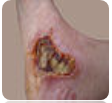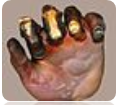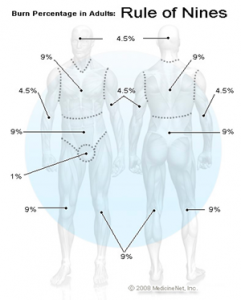Burns are the injuries caused to skin and underlying tissues by thermal (can be flames, hot objects, hot liquids or hot gases/steam), chemical (acids/alkali), electrical or mechanical (friction) causes. Burns occur more frequently in day to day life and may cause death if severe and if not will lead to permanent disfigurement that can be very mutilating.
Burns cause death in several ways,
- Directly destroying tissues
- Causing inner tissues exposed to air leading to oozing of body fluids leading to shock
- Inhalation of hot fumes/steam and facial burns will cause swelling of air ways leading to airway obstruction
- Burning objects (e.g. Plastics) releases an array of toxic gases together with hot gases will destroy lung tissues leading to Adult Respiratory Distress Syndrome (ARDS)
- Reduction of oxygen content in environment (e.g. in a burning house) will cause asphyxia as well as carbon monoxide poisoning
These have to be kept in mind in attending to burn victim.
Outcome of the burn is determined by the type of the burn, surface area of the burn, depth of the burn, distribution of burn (e.g. burns in face, chest, genital areas are considered critical), patients age, underlying diseases (e.g. Diabetes), other injuries and the duration of contact with cause of burn.
Burns can be categorized according to the depth of burns
Burn Surface area is determined by the “Wallace’s rule of nines”
Fig 1: Burn percentage in adults: Surface area of palm considered as 1%
Any burn involving ≥30% surface area of the body in adults is considered ‘Major’ or a serious burn and requires urgent medical attention. Also a burn involving any of vital areas (e.g. Face, Chest, Genitals) considered serious regardless of its size or depth. In children or elderly any burn ≥20% surface area is considered ‘Major’.
First aid management
- Ensure safety first, victims as well as yours. Remove him/her from the vicinity to open air. Be careful in touching him with bare hands as you’ll get burned also.
- If the victims is on flames help him to drop on to ground and roll around to smother flames. Do not allow to run in panic.
- Remove burning or burnt clothing, if adherent to skin cut or tear around. Remove tight jewelry, belts as burns can swell quickly.
- Cooling:
Cooling can be practiced for all flame, chemical or explosion burns. It will reduce retained heat as well as flush out chemicals. So reduces depth of penetration and severity of the damage.
- Use cool (not cold) running water. Tap water is ideal.
- Continue around 20 to 30 minutes.
- Do not use ice, butter or other ointments.
5. Avoid hypothermia:
Surface burning hence loss of skin, removal of cloths and cooling are the factors that can leads to hypothermia in a patient with a burn.
So in order to avoid this keep the victim covered, keep warm and dry.
When transporting be sure that the victim is covered with warm clothing.
6. In the same time try to identify the type and category of burn. If it looks ‘Major’ as described above, or if victim is having difficulty in breathing or unconscious have someone to call 911 urgently while monitoring the his vitals and attending to basic life support as necessary.
7. In Minor/1st degree burns(without affecting vital areas);
- Can be managed at home without hospitalization.
- Other than above mention steps cover the affected are with clean blanket or a sheet but do not use gauze as it can adhere to the wound causing shearing and damage to skin and pain on removal.
- Relieve the pain with over-the-counter painkiller such as acetaminophen, ibuprofen, or naproxen.
- Apply antibiotic cram such as Silver Sulphardiazine (do not use in face).
- Give a shot of tetanus toxoid booster if required.
- Seek medical help if there is continued pain, signs of infection, fever, or oozing.
8. Major burns (2nd, 3rd, 4th degree)/ ≥30% surface area/ vital area burn
- Need urgent hospitalization.
- Do not give any food or water as these interferes with general anesthesia if operative procedure is required.
- Other than above general measures check whether the victim is conscious and breathing. If not secure the airway and go through the steps of Basic Life Support as well.
